Admiral, there be spoilers here!
Have you ever watched a poker tournament on TV…or even just flipped past one while channel surfing? (Do people even channel surf anymore?)
It’s a pretty good bet that you’ve probably seen at least a glimpse of a poker tournament. They’re actually kinda exciting! Every hand is different. Every bet could change the balance of power and the fortunes of any player at any time. The stakes can be high and the tension even higher. It’s no wonder that poker tournaments have found their way onto broadcast television.
But what about chess?
Chances are you’ve never seen a chess tournament broadcast on television…except maybe highlights of one on the news. And why would you? Chess isn’t exactly a thrill-a-second game (although it can be if you know what to look for, but most of us don’t). And unlike poker, where a game is made up of a series of hands that each reset gameplay, a chess game unfolds and develops veeeeeeery slowly and carefully. It’s not what you’d call riveting TV!
Since the very first season of TOS, Star Trek has embraced both the games of poker and chess—from Kirk’s corbomite bluffs to Spock’s 3D chess to the TNG crew’s regular poker nights. And of course, the first episode of STAR TREK: PICARD opens on a dream sequence poker game with Data.
I thought about these two games as I watched the second episode of Picard, “Maps and Legends.” After a very exciting teaser where we see and learn more about the First Contact Day synth massacre on Mars (they were hacked!), the episode very quickly puts on the brakes and doesn’t accelerate again for the rest of the 44-minute episode. It was pretty much all talk—although still dramatic and well-acted—for 37 straight minutes.
This seemed odd to me as a viewer.
The friend I watched with said he definitely didn’t like the second episode as much as the first. The first, he opined, had a message, a theme, of growing older, of looking for purpose in one’s twilight years, of seeing the world change into something your idealistic self wouldn’t recognize nor approve of. But what was the message of the second episode? There wasn’t one that he could see, just scene after scene of mostly exposition.
It wasn’t that either of us didn’t like the episode. We just didn’t like it as much as the first one. And initially, I didn’t understand why. But now I do…
THE MIDDLE OF THE BEGINNING
Episode three will be titled “The End Is the Beginning,” and it will be the third episode in a row directed by HANELLE CUPEPPER. JONATHAN FRAKES is co-directing the third episode and then handling the fourth and fifth himself.
Let’s pause to take a closer look at what I just said.
In the 50-year history of Star Trek (and most TV shows), there are few instances of the same person directing two episodes in a row…let alone three! Directing is time-consuming and exhausting. And with a fast production schedule for a weekly series, the studio wants a director to hit the ground running when a new episode starts shooting. If that same director has just spent the last seven or eight days in production, they’re not necessarily “fresh and rested.” Also, the director usually moves from production into post-production and editing…not into being out on location in the middle of a Vineyard in Santa Ynez for another week. So having the same person direct three episodes in a row is unusual, to say the least…
…unless it’s not really three episodes!
If you think of the first three episodes of Picard as a single, two-hour long made-for-TV movie, then having a single director makes much more sense. You film all the scenes in “France” over a few days, all the scenes of Starfleet together at the Anaheim Convention Center, and you create a story that isn’t really three episodes so much a one episode in three parts. Then that “super-episode” has a single director with a single creative vision delivering a cohesive story with a beginning, middle, and end.
And note that the last of Culpepper’s three episodes is called “The End Is the Beginning.” While that might also have some tie-ins to the content of the episode itself, it’s likely that the “end” of these first three episodes marks the real beginning of the Picard series. These first three episodes are just the set-up.
In chess, the game is usually divided into three phases: the opening, the middlegame, and the endgame. Of these, the opening is typically considered the least exciting. This is because the pieces always start in the same spots, and only certain pieces can be moved at first, like pawns and knights. And it isn’t until some of those pieces are “out of the way” that other pieces can be brought out, like bishops and rooks and the queen.
Notice that the first episode introduced only a few key characters. Then the second episode introduced other key players (including the villains and Picard’s former medical officer on the Stargazer and his former first officer from the USS Verity). The third episode promises to introduce at least one other major character (Hugh) and probably more. In other words, the “beginning” three episodes are setting up the pieces on the chess board, heading into the middlegame…which will be more exciting. Just be patient, my friends.
AKIVA GOLDSMAN, executive producer on Picard, said as much on this week’s episode of THE READY ROOM (with WIL WHEATON) on YouTube at the 18-minute mark. He talked about how TOS and Next Gen “jumped around” to do all kinds of different types of episodes—action, drama, romance, speculative fiction, comedy. But Picard is different…
For us, because we’re serialized, it’s almost like each season is an episode. So our tone is sci-fi drama. Discovery is sci-fi action/adventure—there’s gonna be a lotta things blowing up! Less things blow up on our show. Our show is more performance based. We like to be writing-based. We want people to play scenes that you would expect to see in a drama, but the context being otherworldly and modern and speculative.
So if you watched the second episode of Picard and felt, as I and my friend did, that it was slower, more pensive, and overflowing with exposition…then you’re totally right! But just as a typical episode of Star Trek usually starts more slowly than it ends, the plot and the players in Picard are still being explained to us, and we as viewers shouldn’t be force-fed the entire meal at once because we’ll likely miss something important in the rushed information dump. We must await each new course in order to digest everything and come away from our meal truly satisfied as being treated to a rich, savory experience.
As I said last week, if you want fast food because you’re in a hurry and need to be someplace, then Discovery is where you want to eat, not Picard.
THERE…ARE...FOUR…KNIGHTS!!!
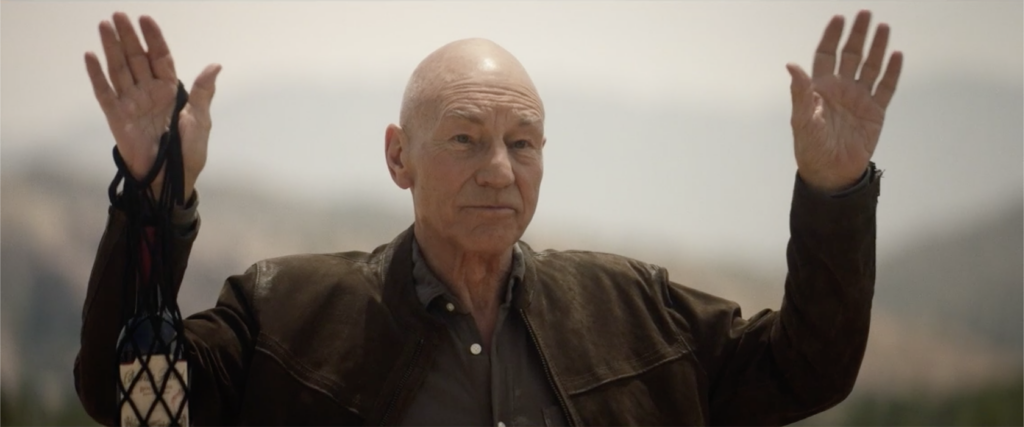
Okay, that sub-headline isn’t as clever as I thought it’d be. I just needed to rhyme something with “lights” that connected to chess. That said, let me explain what I’m talking about…
This was the episode where, if you’re going to get off the starship, now is the time. The reason is that the writers and producers are about to ask you to accept four important aspects of the plot. And if you can’t accept them, you’ll be miserable going forward.
There are already a few fans complaining (although a surprisingly small few) about Picard not being canon because it acknowledges the “controversial” 2009 Star Trek feature film that created the alternate reality Kelvin timeline.
It’s true that Picard is touching on a LOT of Star Trek continuity—certainly from TNG but also from DS9 and Voyager. The first episode already featured nearly two dozen references and easter eggs, and this second episode asks fans to accept even more, as new revelations are being added to that oh-so-sacred cow known as “canon.” If you’re a fan who can’t accept the next four aspects of Picard, well, this is where you might just want to stop watching…
The even-MORE-secret Secret Police
The Federation has Section 31. The Cardassians have the Obsidian Order. And the Romulans have the Tal Shiar. So it was written in TNG and DS9, and so let it be part of the holy Trek gospel!
But now we are told that the Romulans have another clandestine organization even more secretive than the Tal Shiar, and it’s called the Zhat Vash! Of course, we’ve never heard of them before. Their name was never even spoken…just as Spock never spoke of his half-brother Sybok before Star Trek V (or his adopted human sister Michael…although she is now on the “no-speak” list for everyone).
And not only are we supposed to believe the Romulans have had this ancient, super-duper, Illuminati-like sect/cult/cabal for “thousands and thousands” of years, but these zealots obsessively HATE artificial intelligence (which probably didn’t even exist in the Romulan Empire thousands and thousands of years ago). And yet, with that passionate hatred of all things android, these obsessed Romulans super-secret agents who operated without regard for treaty or jurisdiction never once made a move on Data? I mean, they attacked the Enterprise-D and, later, the E, but those always seemed more aimed at Picard, not Data.
Oh, and not only that, but we’re also supposed to accept that, when Picard first hears the name of this super-secret organization, his immediate reaction isn’t, “Did you say ‘Vash’? I used to date a woman named Vash!”
But yes, we have to accept the Zhat Vash to move on with Picard…and I’ve chosen to do just that.
Traitors and spies operating at the highest levels of Starfleet
Actually, this one isn’t nearly as hard to accept. We’ve seen Starfleet conspiracies of the upper brass way too many times: Star Trek VI: The Undiscovered Country, the TNG episode “Conspiracy,” and DS9‘s “Homefront” and “Paradise Lost.” And we’ve seen well-meaning admirals “in league with the bad guys,” like Dougherty in Star Trek: Insurrection. And of course, we’ve seen Vulcans working with Romulans in both Star Trek: Enterprise and in TNG‘s “Unification.”
So the fact that the Starfleet Chief of Security is teaming up with the Romulans and has hired one of their top undercover agents to be her personal assistant doesn’t seem too far outside the realm of possibility. Granted, it’s not the way I’d imagine my ideal Starfleet, but I can believe—especially when there’s such bad (green and red) blood between the two powers—that the weakened Romulans would redouble their efforts at infiltration at the highest levels. Again, if you can’t handle that, escape pods are available on decks 3, 4, and 5.
Bitchy admirals who won’t listen to Picard
Oh, come on! Picard has proven himself a hero twenty times over! Even if it’s been 15 years, how can he have been so easily forgotten that they don’t even recognize that shiny bald noggin at Starfleet HQ reception??? And he’s Jean-Luc Picard, damn it! HOW CAN YOU NOPT LOVE HIM LIKE WE DO???
Well, apparently, a lot can happen in 15 years, and admirals do hold grudges after all. Granted, Admiral Kirsten Clancy wasn’t simply still seething over Picard disobeying orders and mounting a rescue mission a decade and a half earlier. She also saw his explosive interview on the holo. And she was PISSED! Heck, she even used the F-bomb. In fact, that was the third swear word to be spoken during the episode (two F’s, one S). I was so happy after episode one to see no cussing, but after episode two, I am now going to start referring to ALEX KURTZMAN as ALEX CURSE-MAN!
But I digress…
Remember that we’ve seen pissy admirals before. Can you say Nechayev? (Can you spell it?) And let’s not forget retired admiral Norah Satee from the TNG episode “The Drumhead.” So let’s not go all Gene Roddenberry and say everyone gets along perfectly with everyone else in the future. And it’s not that she didn’t believe Picard. Admiral Clancy simply didn’t want to give Jean-Luc a ship and let him gallop around the cosmos (that’s a game for the young, doctor!). But she did immediately contact Commodore Oh (speaking of “O”…anyone see the season premiere of Doctor Who?) and asked her to investigate. Granted, that’s our mole/traitor, but Clancy didn’t know that.
Anyway, in order for the rest of this series to happen, Picard needs to be on his own…without the help or authority of Starfleet. This is the true “STAR TREK: RENEGADES” that fan filmmakers imagined a half decade ago. If you don’t like that approach because you feel strongly that Star Trek needs to be about Starfleet and not rogue, retired recluses with ragamuffin recruits and random riff-raff romping righteously to restrain raging Romulan ruffians and retrieve runaway robots (well, androids actually…but alliteration always wins), then please use the nearest airlock to disembark the spacecraft.
Yes, that was the Discovery version of the original Enterprise
No, I don’t know why they felt they needed to show this shot…
…but they did. It pissed me off because I grew up loving, drawing, playing with, building models of, and dreaming about this version…
The show-runners could have avoided showing it completely…maybe showing the refit instead. But for some reason, they felt they needed to plant the canon flag. In a future blog, I am going to try to “Trexplain” how this universe can now be considered prime/canon/true Trek even if the Enterprise is all f’ed up—and I think I’ve got a workable theory.
But until then, if you’re one of those fans who sees the clip of Picard looking up and seeing the new old Enterprise from Discovery for one second and decides to flip out on Facebook and rant about how this new series has betrayed all true Star Trek fans everywhere, well, then no Trexplanation will help you, and you’ll just be miserable if you watch another minute. So I’ll see you around the galaxy because I’m staying on board.
As I said, the chess pieces of Star Trek: Picard are now being moved across the chess board and getting strategically placed…including these four errant “knights” I’ve just listed. And I think it’s going to be an intriguing game to watch and experience. We just have to wait for more moves from the players.
If, like me, you don’t want the game to end, then accept what’s being presented to us, enjoy the ride, and let’s see where Picard takes us. Engage!

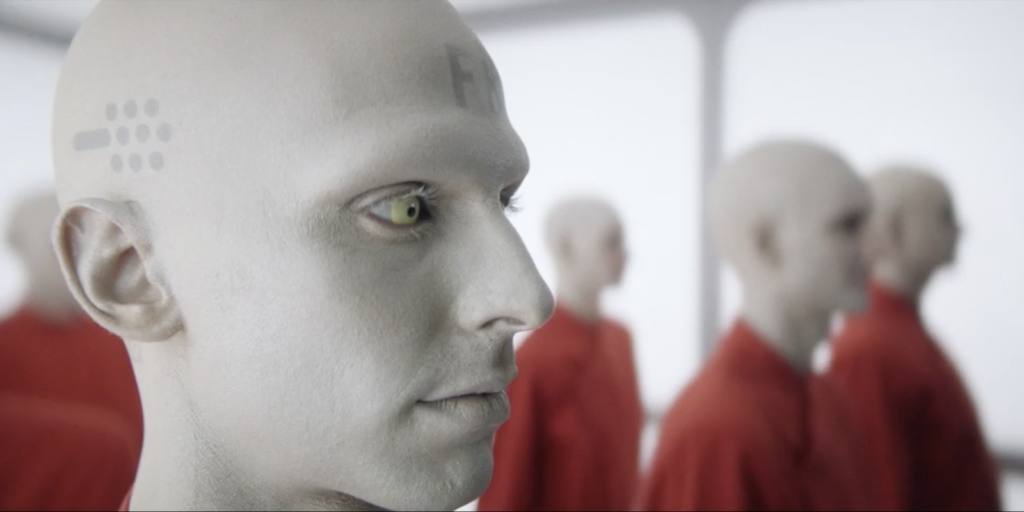


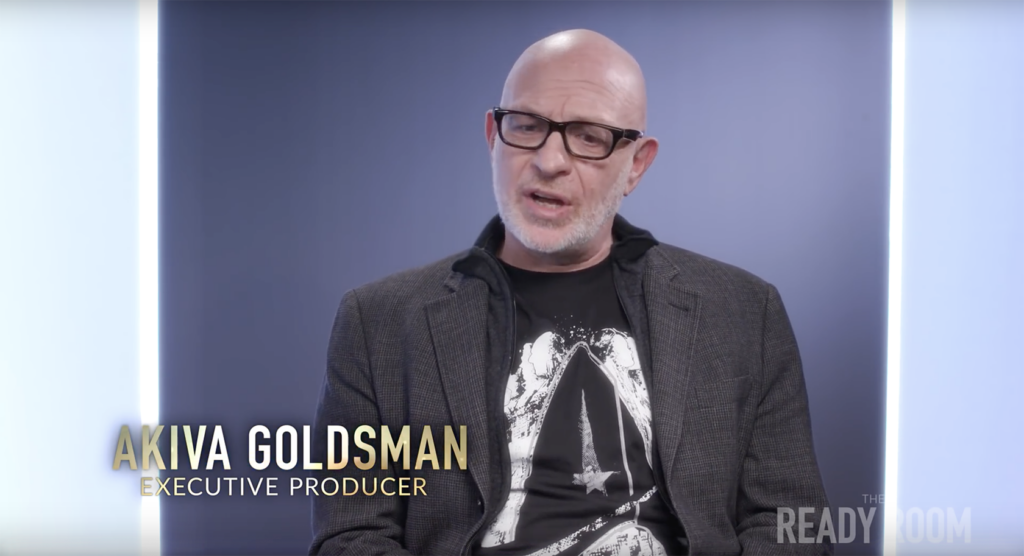
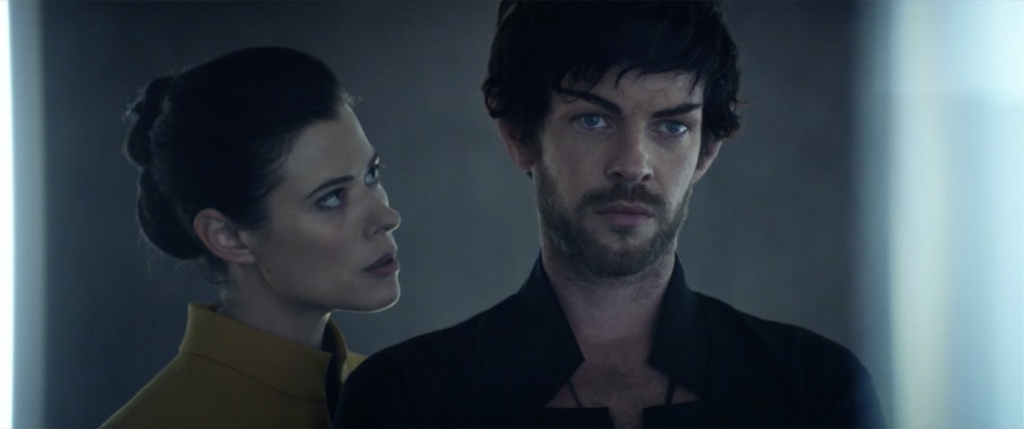
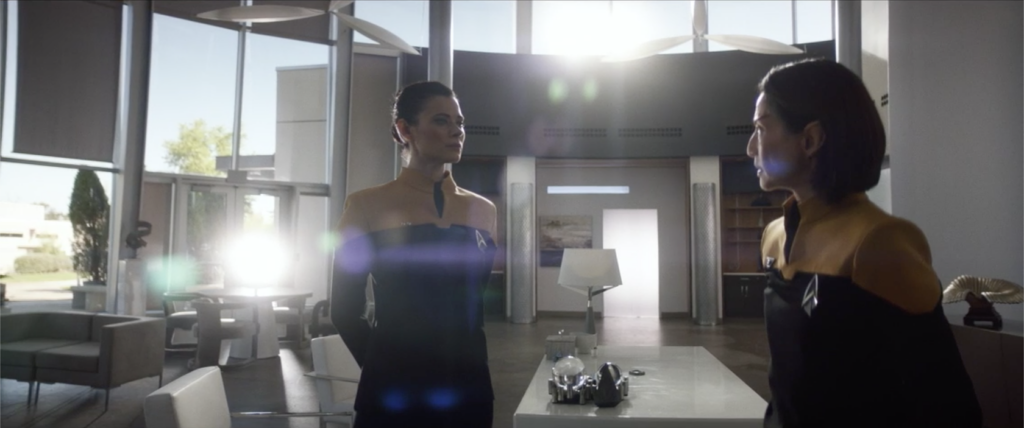

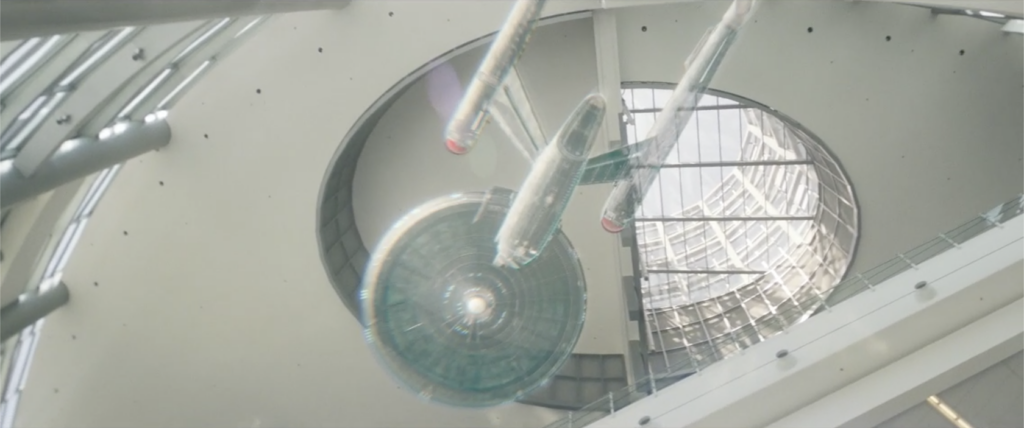
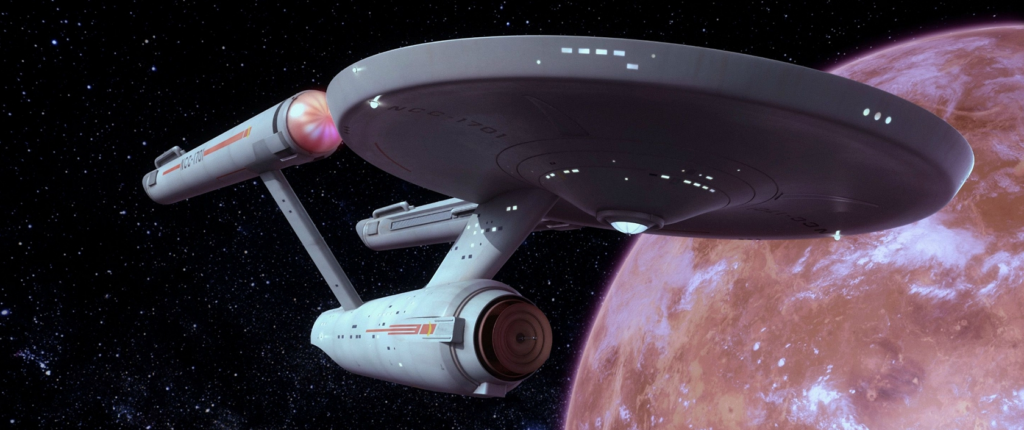
Oh yeah, I still channel surf. Mainly in desperation of actually finding something worth my while watching, and generally despairing of all the garbage that people watch.
I can’t remember the last time I channel surfed! 🙂
Good editorial Jonathan, and ties to the LA premiere event where they showed the first 3 episodes cut together as a movie. So, I have thought however on what has been presented so far…
It appears to me that Star Trek is proving that it takes place in the Ron Moore Battlestar Galactica (BSG) universe. For those that know BSG follow along, for those that don’t let me explain a bit… The theme of BSG right from the beginning is that “All of this has happened before, and all of this will happen again,” and the series demonstrates this happening over and over again, up to the point that Galactica settles on Earth 50,000 years ago (and then hinted at during the last scene). Now lets fast forward to Star Trek Picard (STP).
STP has shown a great number of parallels to BSG:
1. Synths that are made of flesh and blood. So are the final Cylons and what they evolved too.
2. Duplication of a synth is possible with a single neuron, and you can make many copies. This sounds very close too or is the first step in Cylon regeneration.
3. Closing the first episode of STP disclosing there is a twin. On BSG, it was the disclosure of Sharon (Boomer) and on Picard the disclosure of the Dahj’s twin.
4. Rouge synths attacking an entire planet devastating it. Sounds a lot like the Cylons attacking and devastating Caprica.
5. Banning synths from society. Remember in BSG, network computers were banned after the first Cylon attack.
So, if you buy those similarities it seems that the universe of Star Trek is showing that “all of this has happened before, and all of this is happening again!”
Now, of course, I am kidding around but look at the parallels and there are too many to be coincidences. Even the Borg ship in Episode 2 looks vaguely similar to the resurrection ship internally.
Wow, David, you’ve just blown my mind!
And of course, the new Battlestar Galactica was created by Ronald D. Moore, who was co-executive producer on Star Trek: Deep Space Nine. So Star Trek led to BSG which, in turn, led back to Star Trek. This indeed has all happened before and will happen again!
Of course, if this really were BSG, I would have been perfectly okay with Admiral Clancy saying, “fracking.” 🙂
The canon issue is simple. Everything is canon EXCEPT TOS (and TAS if you want). TOS isn’t even consistent with itself and you’re asked to mentally reboot what the characters are like every episode. This is because Roddenberry saw the future through a lot of interference (and 1960’s social biases) and also was hamstrung with limited budget and FX tech. For all that, he did pretty well. But don’t expect 100% continuity with either the backstory or visuals. Yes, I know this doesn’t solve ALL continuity problems with the new CBSAA Treks, but it goes a long way! I for one am having a ball with the new Treks!
I also liked quite less this episode than the first one, and I think that it was because I started to see plot twists too similar to some used in “Discovery”. But I must also say that the almost sedate pace of “Picard” has no resemblance with the hectic pace of “Discovery”, and I find it a very welcome change. Also, while I found “Discovery”‘s dialogs pretentious at the best and dreadful at the worst, I’m enjoying “Picard”‘s dialogs (I chuckled with the “One of my training officers… My mother… drunk of romulan ale… my father…”. And I really like a lot all the scenes in the Borg Cube.
I didn’t like the “molecular reconstruction” scene, as it has no relevance to the plot (it doesn’t works, and they end finding in another place the clues that they need) and only adds unnecessary technobabble. I would like that “Star Trek” ceased to consider technobabble as a required feature instead of a crutch to be used only when there isn’t any other way to advance the plot.
When Picard said that “Starfleet doesn’t has the right to choose which which species lives and which not”, I couldn’t help thinking “Well, Jean-Luc, you hadn’t that attitude in the “Homeward” episode”.
And last, in the list of “things inherited from Discovery”, we see lieutenant Rizzo using a holocomunicator like those used in “Discovery” (although, thankfully, they refrain from making her interact with furniture in the room which is receiving the call).
The holocommunicators were first used in the final season of Deep Space Nine, Alfred, but they were sort of a new invention at the time…not a century-old technology. That’s one of the many problems I have with Discovery and continuity. I’m okay with it in Picard because holographic communications are established tech by 2399.
Yes, I saw “Deep Space Nine” entirely last year, and I noticed the use of the holocommunicator (it is only used in two episodes, “For the Uniform” and “Doctor Bashir, I Presume”). I’m not against the introduction of holocommunicators (I have no problem with retconning its existence as a century-old technology, but I have a quite radical position about canon which can be resumed as “There is no canon”), but I’m against overdoing its use.
What put me off about the holocommunicators of “Discovery” is that the holoprojections seemed to be able to interact with the furniture of the room which was receiving the call (i.e. Sarek being able to sit on the table of Burnham’s room). That was the point which blown my “suspension of incredulity”, because I was thinking: “What is Sarek supposed to be doing in his room? Is Sarek’s room a perfect copy (at least concerning the furniture) of Burnham’s room?” The holocommunicator of “Deep Space Nine” had a very restricted area (marked on the floor) for the holoprojection, and in “Picard” the projected person moves very little, instead of walking around the entire room.
In many ways, Discovery is a “sloppy” and rushed production. And I don’t mean to say that they’re not working very hard on it. But I think the producers and directors (especially the directors) aren’t really well-versed in the long history of the franchise (other than Frakes), and so have a tendency to direct a “cool” scene as the top priority and consider its relevance to established Star Trek canon much farther down the “to do” list. This wasn’t the case on the Paramount series. Most of their directors and all of their producers, were cycled through, over and over again, getting a feel for the show and the history and reality they were crafting. Many of those guys aren’t directing anymore or else were simply not hired by CBS. But with them goes a lot of connection and familiarity with the look, feel logic, and flow of the established franchise.
About STP and BSG similarities, I will add that it would not be difficult to turn Picard’s dreams about Data to something similar to the “Inner Six” visions of Gaius Baltar (especially if some nasty medical condition begins to affect Picard’s mind). And all the people that I know who has seen “Picard” and “BSG” thought about the cylon insurrection since the first moment they mentioned “rogue synths”.
I have read that the original Cylons of “Battlestar Galactica” owe much to Fred Saberhagen’s “Berserker” stories, including Saberhagen’s fictional race The Builders whose “sliding single red eye” became the signature design element for the Cylons. And the Berserkers themselves are supposed to be “doomsday weapons left over from an interstellar war between two races of extraterrestrials”. Considering that the Berserker’s size can range from humanoid size to the size of an asteroid, doesn’t this reminds you a bit of “The Doomsday Machine” episode of TOS?
I think “The Doomsday Machine” might be a little too much of a stretch for me…as is the analogy of Picard’s dream of Data to “inner sex.” 🙂
Maybe I’m in the minority, but I really liked Episode 2 (aka the middle of the movie). Having watched all the trailers I had an idea what’s what since we’ve not seen all those scenes yet.
I’m enjoying seeing the context being revealed. But even more, I’m enjoying playing detective as all the pieces are moved into place. For example, I guessed that the seducer was one of the “bad guys” when I first saw him and was happy to see my guess confirmed.
But I did not know the context until the backstory was revealed later on. When it was, I was happy to realize that it was fitting together.
Yes, there are clunkers like the “thousands and thousands” of years, but I’m used to clunkers and give them a pass a long as it does not become clunker city.
As far as the guy not recognizing Picard, if President Bush (dubya) walked up to a 20 year old, would he be recognized? I’d not be at all surprised to find a hero from the past to not be recognized especially by someone who was the Starfleet equivalent of a Walmart greeter.
I think a better analogy would have been a White House greeter…in which case, not recognizing George W. Bush seems a little less believable. 🙂
So far I have enjoyed these first two episodes of STPic. As I have never (and probably never will) watched STDisc (your editorials of that show – well – caused me to not bother with it), I certainly cannot draw any conclusions of “corrupted timelines” as others seem to; BSG similarities aside (great deductions by David Moss!). And your continual “smacking about” STDisc in that first editorial only confirms for me to not bother (i.e. won’t waste my money on the DVDs).
Jonathan, did you not – in your first editorial for STPic mention in a reply to David Lyon’s post the fact that it was established in the 2009 reboot that Spock (Prime) came through the singularity – thus the implication was that the nova occurred in the “ever precious canon” period of TOS/TNG? 😉 This is something sadly lacking mention of in the two “The Ready Room” episodes, but I myself take to be within “canon”. I didn’t mind the first and third reboot movies – it was the 2nd (and I really enjoy Cumberbatch as an actor), but doing a total rework of TWOK smacked too much of the first season of TNG and at least a third of the season being rewrites of TOS stories. But I too, digress…
Whether or not SFX are “expensive” they could have easily done our beloved TOS Enterprise, as did they not (as far as I can tell) faithfully reproduce the Enterprise-D? The shuttles – well… that I can forgive and pass them off as “industrial or *civilian* use”. But I too am dismayed a little. BUT – at least they *acknowledged* the overall TOS Style! 🙂
So now – how true is it that many critics more or less did not like the three episode “strung together as a near two hour pilot”? I for one am finding this to be an exceptionally entertaining show. Generally, I take most any “new” ST shows with a grain of salt (with STDisc aside). And so I am more than willing to see how these first ten episodes play out. I just hope (for my bank account’s sake!) that CBSAA will show all ten at once with no break!
Now that I’ve written my third blog review, Ken, I’m wondering what your thoughts will be. 🙂
I actually quite like Picard, and got CBS All Access to watch it. I Gave up on Discovery after the first season and just recently started watching season two. Still not happy with a Commander who Wesley’s the whole show, but I am sticking with it for now because of Pike. Picard feels real and visceral, and as a result, I am giving it more leeway.
Canon is whatever the IP owner says it is, whereas head-canon is whatever you decide it is.
Very true! There are four lights!!!!!
Always an enjoyable read JL (see what I did there?)
It’s a relief to have a departure from the whizz-bang pace of Disco, but after two (now three) episodes Picard’s journey is still barely underway, so perhaps they’ve braked too hard. I’m also less thrilled with the lens flares and language of Ep 2 (I’m not against swearing, per se – I just don’t expect to hear it on Star Trek). However, I thought the writers treatment of Picard’s meeting with Adm. Clancy was impressive; it did come across as grand hubris on Picard’s part (he does have an ego, whether he knows it or not), and Clancy’s reaction was what you might expect upon hearing a long-retired and TV-belligerent retired officer ask for a ship and crew.
Still interested to see where the show goes (I cannot say the same for Disco) and Patrick Stewart continues to impress as always. I have a personal (and whacky) theory that Narek is kid brother to Nero from the dreadful JJA reboot – I can’t explain why at the moment, it’s just a wild theory.
LLAP
B
Well, aside from the “N” as the first consonant of the name, I’m not sure I see the similarity of the two characters. Also remember that Nero disappeared 14 years earlier at a middle age. Narek is in his twenties or thirties at most. This means that Narek would have to have been, at best, a wee lad to a teenager when his decades-older “brother” went missing. In other words, the two siblings would hardly know each other.